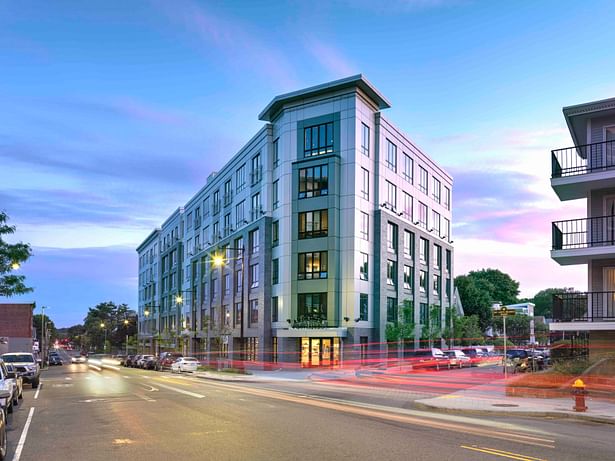

With economic dislocation and uncertainty increasing in recent months, concerns about housing shortages and a lack of affordable living options have taken on fresh significance in cities nationwide. Fortunately, a number of architects and developers are rolling out solutions that address new market trends and these critical issues.
Among them are the affordable housing experts at The Architectural Team (TAT), a firm working nationwide. The firm’s architects, including associate Jay Szymanski and senior project manager Phil Renzi, have identified a number of compelling trends. “We’re seeing a new wave of solutions," says TAT’s Jay Szymanski, AIA, NCARB, LEED AP, an architect with deep experience in affordable housing. Highlights of these include:
- an increased focus on accessible infill and transit-oriented developments,
- a surge in rehabilitation and repositioning to keep deeply affordable projects viable, and
- a movement towards dedicated workforce housing that can fill crucial market gaps.
Three Trends Driving New Affordable Development
1) Infill and Transit-Oriented Developments (TODs)
Developments of infill lots — empty spaces in city blocks, for example — and building near transit hubs are two valuable and highly desirable approaches today, says TAT’s Szymanski, including in smaller metropolitan areas where residents seek attainable housing with easy access to important goods and services. He points to recent examples including Alta Union House in Framingham, Massachusetts, a new 196-unit rental complex that replaced a parking lot and has been lauded as the city’s first downtown multifamily project in 50 years, drawing tenants who sought an urban lifestyle but with lower rents than Boston. In larger cities, compelling examples include Treadmark, a new mixed-use development on a prominent corner site in Boston’s Dorchester neighborhood, and Bower, a two-building complex in Boston that activates a series of former parking lots near the historic Fenway Park stadium.
Long incentivized by local leaders aiming to reduce on-site parking, encourage active transportation, and facilitate downtown growth, infill and transit-oriented development (TOD) projects have added appeal during the current pandemic, says Szymanski. In addition to outdoor space, essential amenities now include bicycle storage, repair, and even e-bike charging facilities — trends which are likely to accelerate with a well-reported surge in bicycle use and nationwide expansions of cycling infrastructure.
2) Asset Repositioning and Moderate Rehabilitation
Cost-effective improvements to affordable housing, including Section 8 properties, has been on the upswing. According to TAT senior project manager Phil Renzi, many developers and multifamily owner-operators are now adding increasingly affordable properties to their portfolio, or stabilizing existing assets to enhance the resident experience, offer community value, and minimize operating costs for the 15-year to 20-plus-year life cycle of many affordable housing tax credits.
With more than a dozen such projects underway in New York, New Jersey, Florida, Virginia, Maryland, Pennsylvania, and Massachusetts, Renzi anticipates this trend will continue expanding as people seek alternative housing options in the current economic climate. TAT’s experts have also advised on the most effective and efficient design solutions for these projects, including phased renovations that enable continued occupancy.
3) Workforce Housing
These middle-income projects continue to fill the affordability gap, adding needed rental homes in cities nationwide. Examples include TAT’s Sibley Square, a new mixed-use community in Rochester, New York: The WinnDevelopment-led property offers multiple residential options within the same building, including Liberty Lofts, a dedicated 104-unit workforce housing community, and Spectra, whose higher-end market rate apartments are rent-adjusted based on income. For cities like Rochester, where 97% of downtown housing units are rentals but over 75% of planned developments are market-rate, broader affordability is seen as essential in the near and long term.
TAT’s Szymanski notes that more state and local governments are stepping up to subsidize these middle-income rental properties based on measures of area median income (AMI). For several years, for example, Massachusetts has contributed to the creation of 1,000 new rental units through its Workforce Housing Initiative. TAT’s team has designed some of these projects in Lynn, Haverhill, Boston, and several other growing cities. Interest in these initiatives is anticipated to expand nationwide.
“From Massachusetts to Florida, and from West Coast to East, we’re working with developers, non-profits, and public officials to add more residential units and expand attainable rental options during this challenging time,” says TAT’s Szymanski.
One of the country’s leading planners and designers of affordable apartment communities, TAT is known for longstanding partnerships with public agencies, housing authorities, and top developers such as WinnDevelopment, Trinity Financial, AvalonBay Communities, and Wood Partners.
Over the course of nearly 50 years, TAT has designed tens of thousands of housing units nationwide, broadening residential options across all income levels in cities as diverse as Worcester, Massachusetts, Bloomington, Indiana, and Jacksonville, Florida.
The firm has served as a powerful advocate for better multifamily housing, including as pioneers in the areas of historic preservation, rehabilitation and adaptive reuse — and as a thought leader in the national media working to raise awareness of such critical development tools as historic and low-income housing tax credits, as well as important development considerations around rising sea levels and climate resiliency for waterfront multifamily properties. TAT’s portfolio of recent multifamily housing work includes notable milestones such as Boston's first living shoreline and its first air-rights project in over 25 years; the first housing development ever funded by Massachusetts’ Workforce Housing Initiative; and the first assisted-living facility funded by a combination of state subsidies, tax-exempt bonds, and Low Income Housing Tax Credits.
No Comments
Block this user
Are you sure you want to block this user and hide all related comments throughout the site?
Archinect
This is your first comment on Archinect. Your comment will be visible once approved.